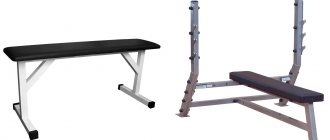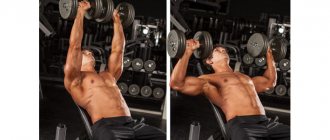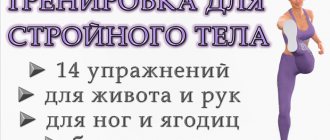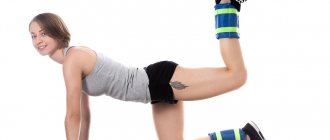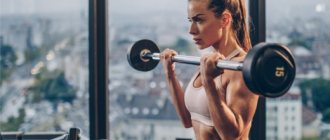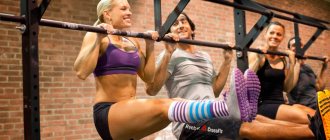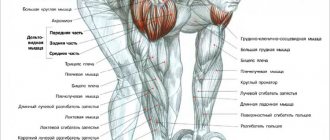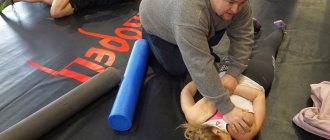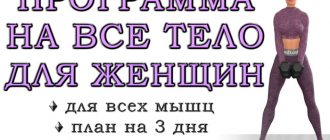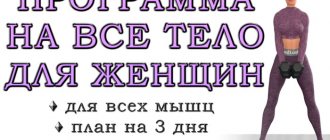Even with a meager arsenal of exercise equipment, you can create a good program for strength training at home. Yes, it may be inferior to a program created taking into account the wide variety of exercise equipment in the gym. But this option will require minimal investment from you - the only sports equipment you will need are collapsible dumbbells with a sufficient number of weights . A wide variety of exercises with dumbbells allows you to exercise almost all muscle groups in the upper body. With legs it will be more difficult, but even here there are a couple of solutions.
How to determine working weight?
Using a simple experiment: start doing an exercise with a certain weight. If after 8 repetitions you have the strength to continue doing the exercise, the weight is too light. Increase it until 8-10 repetitions allow you to perform the exercises to the limit of your capabilities without compromising your technique.
An exception
The experiment above works well for many exercises other than basic leg exercises (like dumbbell squats or dumbbell deadlifts). In them, it is better not to repeat the exercise to failure, as this is associated with the risk of loss of control over the weight, falling and injury.
Instead, just take the maximum possible weight with which you can perform 5 repetitions without compromising your form (that is, with a straight back, arched lower back, etc.). After this, substitute the working weight into the formula (WORKING WEIGHT * 1.09703) + 14.2546. This is how you calculate your one-time maximum. Now multiply your one-time maximum by 0.8. This will be your working weight in basic leg exercises - squats and deadlifts!
You may have different lifting weights for different exercises, so it makes sense to experiment with each one on the list in this program.
As you progress, the working weights will increase, so it will be great if you have a couple of extra dumbbell plates in reserve.
Swing in front of you
Exercises with dumbbells on the shoulders will allow you to form the anterior, posterior and middle bundles of the deltoid muscles.
Swing exercises should be performed with moderate weight as the risk of injury is too high.
Subsequence:
- Place your legs slightly wider than your shoulders, tilt your body forward 10-20 degrees, and direct your gaze forward.
- As you exhale, spread your arms to the sides, bringing them to shoulder level.
- Return to the starting position while inhaling.
Number of approaches and repetitions: 3-4 x 12.
Swings with dumbbells can be performed with each hand in turn, this will allow you to observe the correct trajectory of the hand and prevent injury in time.
Who is this program for?
This program is best suited for beginner athletes: there are no complex movements, and the technique of most exercises is easy to master. The program includes exercises for all key muscle groups, both isolation and compound compound exercises, which can work to increase testosterone and growth hormone levels.
The program can also be used by advanced athletes who temporarily cannot afford to go to the gym. Outside the gym, it will help not only maintain, but also gain muscle. The latter can be achieved by progressing in working weights and using advanced techniques - for example, drop sets or forced reps.
Lunges
The lunge exercise will help to effectively work out the gluteal group.
- Place your feet together, stretch your arms with the apparatus clamped along your hips.
- Take your first lunge until your front knee joint is at 90 degrees. In this case, it is advisable to touch the floor with the knee of the back leg.
- Push off with your back leg and return to the starting position.
With lunges, quantity is everything. Therefore, 4 sets of 12 times will effectively hammer your legs and buttocks.
Rules for effective training
- The workout should not last longer than 45 minutes.
- After 2-3 months, the training program loses its effectiveness, so it is worth changing it.
- It is better not to stretch pauses between repetitions longer than 2-3 minutes, unless you feel an urgent need for it.
- Try to keep your working weight up from workout to workout.
- Do basic exercises at the beginning of your workout, isolation exercises at the end.
- Don't chase heavy weights that prevent you from performing technique. Technique is the main thing!
Recommendations
To start building muscle mass and burning subcutaneous fat, you should follow three fundamental rules:
- Quality training . Before training, mentally “scroll” in your head what exercises you will do today, with what weight, how many approaches, how much rest you will have between approaches, etc. Create a training plan. Keep a diary where you will mark your achievements. Training should always begin with a high-quality and proper warm-up. Select the weight in such a way that the extreme repetitions are extremely difficult or only with the help of a partner. Train for no more than 60-70 minutes, excluding warm-up time.
- Proper nutrition . Eliminate “junk” foods from your diet: soda, chips, fast food, alcohol, sausages and much more. Start eating smaller meals (5-6 times), counting calories. In the morning, more slow carbohydrates (porridge, durum wheat pasta, sweet potatoes), and in the evening proteins (chicken fillet, fish fillet, low-fat cottage cheese, egg whites). Eat a lot of fresh vegetables and herbs. Buy vitamin complexes, omega 3-6-9 fats. Drink plenty of regular drinking water (at least 2 liters per day).
- Recovery . Sleep at least 8 hours at night, and if possible, a couple of hours during the day. After training, take a contrast shower. Ask your better half to give you a massage. This will speed up the recovery of damaged muscle fibers. Get outdoors more and spend time with your family. Less stress.
Dumbbell training program
Monday: Chest-Biceps
#1 Dumbbell Bench Press
One of the best basic exercises for working the chest. Usually performed with a barbell, but the dumbbell version allows for a better stretch of the pecs at the bottom.
Work: Mainly - pectoral (pectoral) muscles, secondarily - the anterior delta and triceps.
How much to do: 4 sets of 10 repetitions
Technique: Sit on a bench with dumbbells, move your arms to the sides so that the angle is right. As you inhale, press the dumbbells up, pause at the top point and exhale. Lower the dumbbells to the starting position.
If there is no bench: The exercise can also be done on the floor. The disadvantage of this technique is that at the bottom point the dumbbells will not be suspended and the chest muscles will not stretch.
#2 Weighted push-ups with high feet
As an option, instead of weights, you can do push-ups with an expander.
Typically, a barbell or dumbbell press on an incline bench is performed on the top of the pecs. Since you may not have it at home, it is advisable to replace incline presses with push-ups with high legs positioned with weights in the form of a backpack with a load.
Work: Mainly - the top of the pecs, secondarily - the anterior delta and triceps
Preparation: Here you will need a weighted backpack. You can hide dumbbells or a few water bottles in it. If doing push-ups with weights is difficult, start without it, and over time add weight to your backpack.
How much to do: 4 sets of 10 repetitions
Technique: Throw your legs onto any surface elevated above the floor - a bench, chair or bed. Palms are shoulder-width apart. The arms are almost straightened. Slowly lower yourself down until your forehead is a few centimeters from the floor. Hold for a second and slowly return to the starting position.
#3 Standing dumbbell curls with supination
One of the most popular biceps exercises. It can be performed without turning the hand, but in this case the effectiveness of the exercise will decrease.
Works: Biceps. To a lesser extent - brachioradialis and brachialis.
How much to do: 4 sets of 10 repetitions
Technique: Stand up straight, hold dumbbells in your hands, palms facing your body. Raise the right dumbbell up, turning your palm towards you (this is called supination). Pause at the top and slowly return the dumbbell to the starting position. Repeat the same with the other hand.
A detailed analysis of the technology is here.
#4 Standing spider curls
Works: Biceps. To a lesser extent, brachialis.
Spider curls are usually performed on an incline or Scott bench. The option without them is no worse: the main thing is to take a stable position.
How much to do: 4 sets of 10 repetitions
Technique: Bend forward so that your elbows are tucked between your thighs. Dumbbells - on straight arms, gaze directed to the floor, neck continues the line of the spine. Press the dumbbells up toward your chest. At the top point, pause and slowly return to the starting position.
A detailed analysis of the technology is here.
#5 Concentrated curls
A good exercise for the peak of the biceps. They can be used to finish off the target muscle at the end of the workout.
Works: Biceps. To a lesser extent, brachialis.
How much to do: 4 sets of 10 repetitions on each arm.
Technique: Sit on a chair or bench. Place your triceps on the inside of your knee. Tighten your biceps and press the dumbbell up, supinating your hand so that your palm faces your face. Pause at the top and slowly return your arm to the starting position. Do a similar exercise with your other hand.
If there is no bench: The exercise can be performed on a chair, stool or bed.
Wednesday: Back-Triceps
#1 Bent-over one-arm dumbbell row
Classic back exercise. Working with one hand allows you to better control the technique, and a wide amplitude allows you to load your lats well.
Among other things, the exercise will help to work out the lagging side of the lats.
Works: Latissimus and teres dorsi muscles. To a lesser extent - diamond-shaped, lower trapezius and rear deltoid.
How much to do: 4 sets of 10 repetitions on each side.
Technique: Place your right knee on the bench and support yourself with your right hand. The angle between the lower leg and thigh is straight, and the back is located at an angle of 45 degrees to the horizontal. In the left hand there is a dumbbell, which is located in a canopy, the shoulder is relaxed. Strain your back and pull the dumbbell to your waist. Pause and slowly return to the starting position. Repeat the same with the other hand.
If you don't have a bench: You can easily replace it with a couple of chairs. The backrests will not interfere, since only one hand works in the exercise.
#2 Standing dumbbell row
A little more difficult in technique than one-arm dumbbell rows. But in it you have no other point of support other than your legs. Due to this, the core muscles are in static tension.
Works: Latissimus and teres dorsi muscles. To a lesser extent - diamond-shaped, lower trapezius and rear deltoid.
How much to do: 4 sets of 10 repetitions.
Technique: Tilt your body 45 degrees to the horizontal and bend your knees slightly so that your butt goes back. The back is straight, dumbbells are on outstretched arms. Pull the dumbbells back, pulling them towards your body. At the top point, tighten your lats and pause. Slowly lower the dumbbells down to the starting position.
#3 Shrugs with dumbbells
Trapezius is a fairly strong muscle. To load them, you should take more weight.
Work: Trapezius muscles, to a lesser extent - rhomboid muscles.
How much to do: 4 sets of 10 repetitions.
Technique: Take dumbbells and stand straight. Turn your palms towards your body. Pull your shoulders up. Pause at the top and slowly lower your shoulders to the starting position.
#4 French press with dumbbell
As in the previous exercise, here you will need more weight, since two hands are working with one dumbbell at once.
Works: Triceps. Accessory muscles: trapezius, rhomboid.
How much to do: 4 sets of 10 repetitions.
Technique : Stand up straight, pick up a dumbbell. Keep your weight on your arms outstretched, elbows slightly bent. The dumbbell is located behind the back of the head. As you inhale, bend your arms so that it goes straight behind your head. Take a break and, as you exhale, return to the starting position.
#5 Narrow push-ups with weights
Triceps push-ups with a narrow arm position are best performed with weights so that the muscles receive enough load for explosive growth. If desired, the hands can be placed even more tightly so that the thumbs and index fingers of adjacent hands form the shape of a rhombus, or diamond. This type of push-up is called diamond push-ups.
Work: Triceps, to a lesser extent - the inner side of the pectorals.
Preparation : You will need weights. For example, a backpack with a load - bottles of water, dumbbells or something equally heavy.
How much to do: 4 sets of 10 repetitions.
Technique: Take a lying position so that your palms are located at a short distance from each other - slightly narrower than shoulder width. As you inhale, slowly lower to the bottom point, pause, and as you exhale, return to the starting position. During the exercise, the elbows should be pressed to the floor and the body should be extended into a string.
Friday: Legs-Shoulders
#1 Deadlift with dumbbells
This is one of the best basic exercises that works several muscle groups at once. Due to this, it causes a good anabolic response, including a surge of growth hormone.
Unlike the classic deadlift with a barbell, the version with dumbbells puts more stress on the forearms and allows for better control of the weight, and therefore is easier from a technical point of view.
Works: gluteus maximus, hamstrings, quadriceps. Auxiliary muscles: trapezius, gluteus minimus, abs, arm muscles.
How much to do: 3 sets of 10 repetitions.
Technique : Stand in front of dumbbells. Sit down, take them so that your palms are facing you. Slowly work your way up, keeping the dumbbells close to your hips. Keep your back straight and maintain a slight arch in your lower back throughout the movement.
#2 Squats with dumbbells
Dumbbells can be held to the sides of the body or in front of you.
See for yourself which option is easier for you to maintain balance. This exercise is much easier to perform than the version with a barbell on your shoulders. That is why it is good for beginners.
Like the barbell option, it can be classified as basic - it loads a large number of muscles and causes the secretion of anabolic hormones.
Works: hamstrings, gluteal muscles. Auxiliary - thigh biceps, lower leg.
How much to do: 3 sets of 10 repetitions.
Technique: Stand up straight, arms along your body, palms facing the body. Inhale, bend your lower back slightly and squat down. As soon as your thighs are parallel to the floor, take a short break and return to the starting position.
#3 Calf raises with dumbbells
The option with a barbell is demonstrated here.
With dumbbells, the technique doesn’t change: you’ll just have a dumbbell in your hands, not a bar. It is best to perform the exercise on a staircase, so that at the bottom point the calves stretch under the weight of the body. As an option, you can stand on a platform, barbell or board. The main thing is that the support is reliable.
Before you do the exercise, practice doing it without weight. You need to learn to keep your balance so as not to fall backwards.
If you are training on stairs, it is safest to hold the dumbbell in only one hand and hold the railing with the other.
Works: Calf and soleus muscles.
How much to do: 4 sets of 10 repetitions.
Technique : Take dumbbells and stand straight. Place your toes on the platform or step so that your heels do not rest on the surface. As you exhale, tense your calves and rise onto your tiptoes so that your heel goes up. At the top point, pause and at the bottom, return to the starting position.
#4 Seated dumbbell press
An excellent exercise for all three deltoids - anterior, middle and posterior. The latter works to a lesser extent, but we will “finish” it in the next exercise.
With heavy weights, it is better to perform the exercise on a chair: the backrest will help the back muscles keep the body vertical.
Function: Three deltoid bundles. Auxiliary - triceps, pectorals.
How much to do: 4 sets of 10 repetitions.
Technique: Sit up straight, look ahead. In the starting position, the angle at the elbows is about 90 degrees, the elbows are exactly under the dumbbells, the dumbbells themselves are at shoulder level. As you inhale, press the dumbbells up so that they come close to each other almost tightly. Pause and slowly lower the dumbbells to the starting position.
If there is no bench: The exercise can be performed on a chair or stool.
#5 Bent-over dumbbell raises
The exercise focuses the load on the rear, most massive deltoids. It is he who sets the main volume of this muscle group, so you should not neglect bent over swings.
Work: Posterior head of deltoid. Auxiliary muscles are the trapezius and rhomboid muscles.
How much to do: 4 sets of 10 repetitions.
Technique: Take a dumbbell in your hands and lean forward so that your body is parallel to the floor. Keep your back straight and slightly arch at the waist. The dumbbells are located below on barely bent arms. As you inhale, lift the dumbbells up as high as possible. Feel the tension in your rear deltoids and pause. Slowly return to the starting position.
Dumbbellsworkout at home
Let's sum it up
Using exclusively dumbbells and a bench for training cannot be considered a disadvantage. After all, they allow you to train every muscle group in the comfort and safety of your home. You can also work out at absolutely any time - because your home gym is never closed! If you simply exercise diligently, eat right, and get enough sleep, the above workouts will help you become stronger and more muscular.
Source:
https://fitnessvolt.com/best-dumbbell-workout/
Legs and abs
Goblet Squats
Standing straight, arch your back slightly and hold the apparatus in front of you. During the exercise, it is strictly forbidden to bend your back. Squat technically, without falling down, until the dumbbell is as close as possible to the floor, and then return to the first position.
Dumbbell overhead rotation
This exercise is performed standing, holding the apparatus above you. Move the dumbbell clockwise the required number of times, and then change to the opposite direction.
"Woodcutter"
Standing straight, hold the apparatus in both hands above your shoulder. Squat down a little, lower the projectile along an inclined line across the body, and then move backward, returning to the first position.
Lunges
Standing straight, lower your arms with dumbbells along your body. Next, you need to take a step forward so that your legs are bent at a right angle, and then push with your front leg to stand up again and return to the first position. Switch legs after completing reps.
Squats
Standing up straight, with dumbbells already taken in each hand, begin to squat as low as possible, and after reaching the minimum height, begin to jerk the dumbbells upward in order to take the first position.
Crunches
For this exercise you need to lie on the floor. The dumbbell should be at chest level. Start by tensing your abs, and then lift your torso and back to a fixed position.
FAQ
How to pump up your back muscles and trapezius in particular?
You can perform the above complex for the back by adding shrugs to it. This is a standing shoulder raise, also performed with dumbbells.
Which is better: barbell or dumbbells?
These are different equipment, but if you need to choose one, it is better to buy dumbbells, they use more stabilizer muscles.
Is it possible to lose weight by doing strength training?
Yes, this is possible, but still the best aids to losing weight are cardio exercise and nutrition control.
Is it possible to build muscle in a month?
If you practice actively, the first results will be noticeable within 3-4 weeks.
